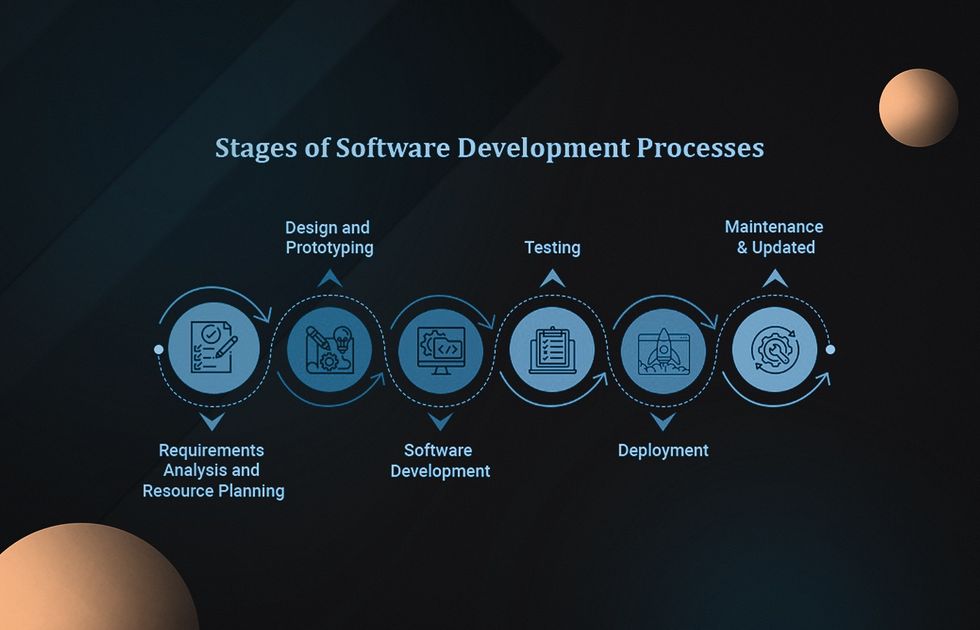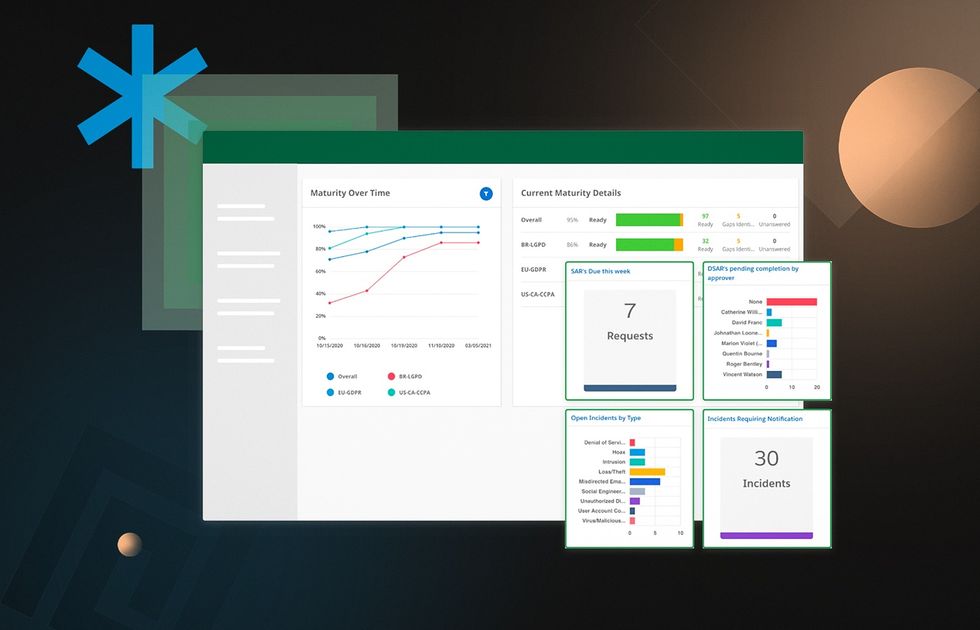
In today’s ever-evolving business landscape, firms get more vulnerable to various hazards. As a result, the need for a reliable risk management solution becomes more relevant.
According to the Third-Party Risk Management Global Survey, companies feel most insecure about managing geopolitical (61%), climate change (58%), subcontractor risks (55%), and chance of becoming dependent on a limited number of vendors (53%). So what to say about the more significant dangers like employee fraud, insider attacks, and other common mistakes that stand out in the millions of dollars?
To deal with hazards, many companies are turning to risk mitigation software. It requires investments but also allows businesses to identify potential risks, assess their likelihood and impact, and develop strategies for minimizing or avoiding them.
Acropolium is a development company with a solid portfolio of risk management solutions, including staff operation, weather monitoring and alerting, and refugee access control.
In this article, we will share our expertise and discuss the risk mitigation software benefits, its core minimum viable product (MVP) features, and things to consider before development. Also, you will learn about the pros of health care risk management software.
Why Risk Management Is Important for Organizations [Healthcare Example]

Risk management identifies, assesses, prioritizes, and develops strategies to mitigate or minimize risks. It helps prevent and overcome issues in companies of various sizes and industries.
For example, the benefits examples of risk management in healthcare include the following:
Improved Patient Safety
The patient is the first who benefits from risk management in healthcare. It involves identifying and assessing potential hazards in equipment malfunctions, medication errors, and falls. Also, it helps develop protocols and guidelines for patient care, conduct regular safety inspections, and provide ongoing staff training and education.
Healthcare risk management software enables providers to track and analyze incidents, identify trends and patterns, and implement corrective actions to prevent similar occasions.
Data Security
Patient data security has become a significant concern with the increasing use of electronic health records (EHRs) and other digital technologies. Risk management tools used in healthcare imply encryption, password protection, and access controls to protect data from unauthorized access, hacking, and breaches.
Examples of risk management in hospitals involve training staff members on best practices for data security. They learn to avoid phishing scams, update software, and maintain secure passwords. As a result, it minimizes security breaches caused by human error or negligence.
Increased Compliance Management
Risk management software for healthcare helps organizations comply with a range of regulators, such as:
- Health Insurance Portability and Accountability Act (HIPAA), designed to protect the privacy and security of patient’s health information
- Affordable Care Act, including healthcare risk management tools related to quality reporting, patient safety, and reimbursement
- Joint Commission Accreditation with standards related to patient safety, infection control, medication management, and others.
Enterprise risk management in healthcare must consider compliance seriously. Punishment for its breaking includes civil and criminal penalties, reputational damage, legal costs, and even license loss.
Effective Communication and Collaboration
Healthcare incident reporting software promotes open and transparent communication and collaboration between staff members.
A culture of safety allows employees to speak up about hazards without fear of retaliation or blame. And interdisciplinary teamwork helps identify potential risks from different perspectives and develop more comprehensive management strategies.
Reduced Costs
Risk management in healthcare organizations helps identify and address potential risks before they lead to adverse events, costly to providers and their patients. For example, physicians can prevent medical errors, causing increased hospital stays, readmissions, and additional medical treatment.
Also, risk management in hospital reduces the risk of liability and litigation, avoiding legal fees and settlements.
Improved Reputation
Adverse events, such as medical errors or data breaches, can quickly become public knowledge and damage a healthcare organization’s reputation. Patients, staff, and investors are likelier to trust if a vendor uses health & safety management software to prevent such events.
Compliance with regulations and standards also demonstrates a commitment to patient safety and quality of care.
Potential Crises Businesses May Face

Risk management software can help organizations prepare for a variety of crises, including:
Natural Disasters
Natural disasters like hurricanes, earthquakes, floods, and wildfires can significantly impact businesses. They can disrupt supply chains, damage infrastructure, and cause widespread power outages.
Disaster management systems help organizations identify potential risks and develop mitigation strategies to minimize their impact. For example, companies can create emergency response plans, establish communication protocols, and ensure backup power.
Cybersecurity Breaches
You should always be aware of data breaches, malware attacks, and phishing scams. In addition, cybersecurity issues can damage money losses and a company’s reputation.
Emergency response software allows organizations to identify possible vulnerabilities in their IT systems and develop security protocols. They include multi-factor authentication, monitoring network traffic, and conducting regular security audits.
Supply Chain Disruptions
Supply chain disruptions can occur due to various factors, such as transportation disruptions, labor shortages, and supplier bankruptcies. They may cause delays in delivery, production slowdowns, and increased costs.
Organizations use crisis management software to identify potential risks and mitigate their impact. In this case, tracking suppliers, monitoring inventory levels, and establishing alternative sources of supply can be helpful.
Financial Crises
Financial crises, such as stock market crashes or economic recessions, significantly impact businesses. These events can lower product demand and revenue or increase debt.
Risk management system software helps organizations identify potential financial risks and take preventive measures. Due to mitigating strategies, businesses conduct stress tests, analyze cash flow, and establish contingency plans for various scenarios.
Core Features to Include in Risk Management Software MVP

Risk or disaster management software has many options available, but it can be challenging to determine which are essential for an MVP. Let’s overview the crucial features that meet your business needs:
Risk Identification and Assessment
Incident management solutions let users to identify potential strategic, operational, financial, and reputational risks, evaluate their impact, and document it. This way, companies can prioritize risk management efforts and allocate resources accordingly.
Risk Evaluation and Prioritization
Emergency management software enables companies to assess and prioritize identified risks based on their potential impact and likelihood. It helps organizations focus their risk management efforts on the most critical risks and mitigate them.
Risk Mitigation Planning
Planning features include developing new policies, investing in new technologies or equipment, improving staff training, assigning responsibilities, and setting timelines.
Incident Tracking and Reporting
Risk management software solutions let companies document and track all accidents, injuries, or security breaches. So they can identify trends and patterns and proactively prevent future incidents.
Compliance Management
Managing compliance with regulations and standards includes tracking and reporting issues. In addition, it helps organizations avoid fines and reputation losses.
Audit and Assessment Management
Incident response management software should provide tools for customizable audit checklists and assessment templates, assigning tasks, and staff responsibilities. Also, it can cover automated notifications and reminders, robust reporting, and analysis capabilities.
As a result, businesses identify growth areas and ensure their safety management tools are practical and up-to-date.
Dashboard and Reporting
Dashboards and reporting provide companies with an easy-to-use, visual representation of risk management data. It can include customizable solutions, data visualization tools, flexible reporting options with all crucial metrics and indicators, and the ability to create automated reports and alerts.
Collaboration and Communication
Risk mitigation software should facilitate collaboration and communication between involved stakeholders. It covers sharing information and updates, assigning tasks, and providing feedback. Some solutions may also include messaging and chat functionality.
Integration and Customization
For efficient work, the risk management app should integrate with other commonly used software and tools. Also, they include the ability to customize workflows, forms, and reports to fit the business’s specific needs.
Things to Consider Before Risk Management System Development

Let’s divide the process of risk management software development into six main stages:
- Planning. It involves gathering information about the project requirements and understanding the scope of work. Also, it is the right time to create a software requirements specification (SRs), schedule milestones, and identify stakeholders.
- Design. Risk management solution companies create wireframes, define the system’s architecture, and design the user interface. Here, you can identify potential issues and make changes before the actual development work begins.
- Development. This stage covers the front-end, back-end, and database. The front-end includes the user interface, the user experience, and visible application elements. The back-end is responsible for the application’s logic and processing, and it is usually called coding (here, you can use low code). And the database is where the application stores and retrieves data.
- Testing. The developers provide unit, integration, system, user acceptance, performance, and security testing.
- Deployment. The deployment stage includes app installation, configuration, and deployment.
- Maintenance. Fixing bugs and updating software components keep the product functional, secure, and up-to-date.
There are several key factors to consider when developing a risk management application:
Relevant Risks
Before developing an incident reporting system software, it is vital to identify the potential hazards relevant to your industry. Here you need to conduct a thorough risk assessment and analysis.
Thoughtful Risk Management Process
After risk identification, determine the management process, including the steps involved in risk assessment, mitigation, and monitoring.
Regulatory Compliance
Regulatory requirements depend on your industry and providing services. Therefore, ensure the crisis management app complies with all relevant regulations and standards.
Well-Designed UI/UX
UI/UX design affects how users interact with the incident response software. So create a visually appealing, clean, and intuitive interface. Make sure that UX design considers user personas and their journeys. And don’t forget to include clear and concise instructions.
Secure Data Management
Emergency management systems often deal with sensitive and confidential data. Use robust data management features to protect it from unauthorized access or loss.
Easy Integration with Other Systems
Your incident management software system may need to integrate with enterprise resource planning (ERP), customer relationship management (CRM), or other third parties. Ensure that it can connect seamlessly with them.
Scalability in Mind
As the volume of data and users grows, the safety reporting software should scale up. Always remember about scalability and potentially high loads.
Training and Support
To improve the crisis software efficiency, provide accessible user training and support. For example, user guides, online tutorials, or help desk support.
Risk Mitigation Software Benefits

A crisis management solution is software that helps businesses manage and mitigate hazards. It provides a comprehensive suite of tools and functionalities for identifying, assessing, and managing risks.
The benefits of risk management platform for businesses include the following:
Improved Risk Identification and Assessment
You can conduct a detailed risk analysis and prioritize them based on potential impact. This way, businesses make more informed decisions and allocate resources to mitigate risks before they escalate.
Enhanced Incident Tracking and Data Management
Emergency management solution allows businesses to track and manage incidents more effectively. They can capture incident-related data in real-time, including its nature, the parties involved, and impact. Generating reports can help analyze incident trends and patterns and identify improvement areas.
Streamlined Communication and Response Efforts
Risk software improves communication and response efforts by sharing incident information. With automated response workflows, chats, and notification processes, all right people are informed, and businesses can respond to incidents quickly and efficiently.
Increased Compliance Management
Risk mitigation in healthcare or fintech enables businesses to manage regulatory compliance, reducing the risk of costly fines, penalties, and reputation losses. It provides automated workflows, alerts, and customizable compliance checklists and templates. This way, organizations can track and monitor compliance requirements and ensure they meet regulatory standards.
Improved Reporting and Analytics
Robust reporting and analytics tools allow companies to generate accurate and timely reports, track progress, and identify growth areas. The risk management software tools can also provide advanced analytics capabilities, allowing employees to identify incident trends and patterns. So you can make more informed decisions, reduce costs, and enhance patient outcomes.
Crisis Management Software Case Studies

To see the positive outcomes of crisis management systems, let’s overview Acropolium cases:
Operational Command Software Development
The client asked us to optimize and improve the solution for operational management, communications, command, and video surveillance. The target audience of the platform is industry, government agencies, and aid organizations.
The current risk management system was too slow, insecure, and contained many bugs. As a result, we created a single information space by integrating the system with GPS trackers, IoT devices, and digital communication devices.
We also expanded the functionality by adding the ability to view the information in real-time, as well as store it as evidence, constantly monitor public places, create closed channels, and exchange data between municipal services.
Bespoke Emergency Helper Software Development
After analyzing the market, we devised the idea to create a risk management tool that would help people in emergencies.
With it, users can share information about the incident by sending geodata or an image. The data is distributed among the respective dispatchers.
The application works even without the Internet and covers all possible emergencies related to social services, city and security services, and isolated objects. And most importantly, the solution can be integrated with any area.
Refugee Access Management Software Development
The client wanted to improve and scale the refugee control and access system. The idea was to restrict people from specific locations based on age or other criteria.
We found that the existing incident response management tools did not work as they should and had big problems with data security. Therefore, we created a new platform with access and restrictions, integrated barcodes, biometric verification, and a video surveillance system — and moved it to the cloud.
It allowed manufacturing, government agencies, and aid organizations to gain control over refugees, excluding human error. Also, it reduced security costs by 78%.
What lessons can we learn from these emergency response solutions? Acropolium’s team defined three crucial conclusions:
- The reliability and scalability of cloud solutions allow the implementation of complex functionality
- For the accuracy of the predicted results, operate a large amount of diverse data
- Data security must be a priority not only in risk management for healthcare
Why Choose Acropolium?

Acropolium is an experienced risk management software development company with a proven work methodology and advanced technology tools:
- We have experience developing video surveillance systems, maps and geolocation services, custom event applications, weather monitoring solutions, and complex software for emergency services.
- Our clients cover enterprises, large manufacturers, governmental and educational institutions, risk management startups, emergency services, and meteorologists.
- We provide software reliability and scalability using cloud solutions like Microsoft Azure or AWS.
- We use blockchain to secure transactions.
- We ensure the quality of the workflow and data protection by following the GDPR standards and ISO-certified processes.
- We use GIS services to capture and interpret geographic data.
- And to work with data, we employ the potential of AI/ML technologies.
Final Thoughts
Risk management in healthcare, fintech, manufacturing, or other business is essential in today’s dynamic and ever-changing world. It allows companies to improve risk identification and assessment and mitigate natural, financial, supply chain, and cybersecurity issues. Also, with the right software, you can reduce costs and enhance your brand reputation.
If you are unsure about the cost of bespoke software development, pay attention to Acropolium’s subscription-based service. We provide a reliable outsourcing option for businesses of all sizes to manage risks and ensure the successful building of their software projects. Please contact the team to learn more about our cases or workflow features.











![Renewable Energy Software Development in 2025 [Use Cases & Solutions]](/img/articles/software-for-renewable-energy-sector/img01.jpg)

![8 Machine Learning Use Cases in Key Industries [2025 Guide]](/img/articles/use-cases-for-machine-learning-adoption-in-key-industries/img01.jpg)
![Retail Software Development Guide for 2025: [Features + Cost]](/img/articles/custom-retail-software-development/img01.jpg)